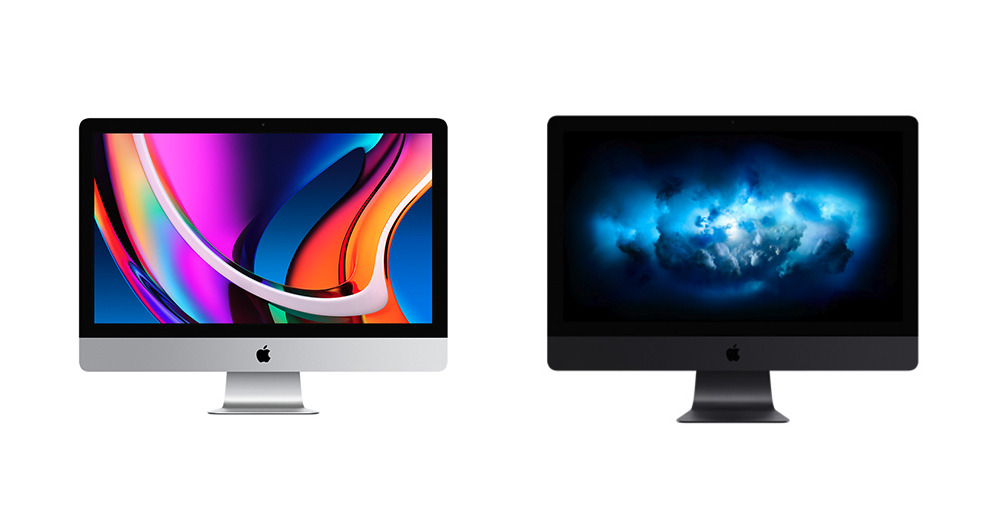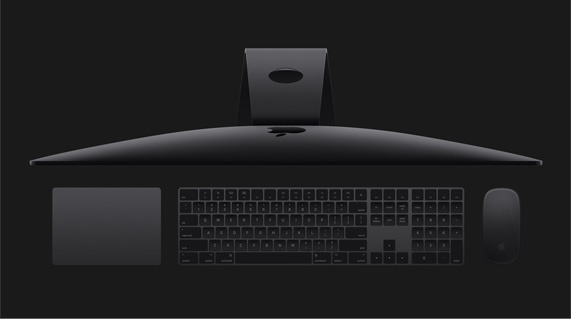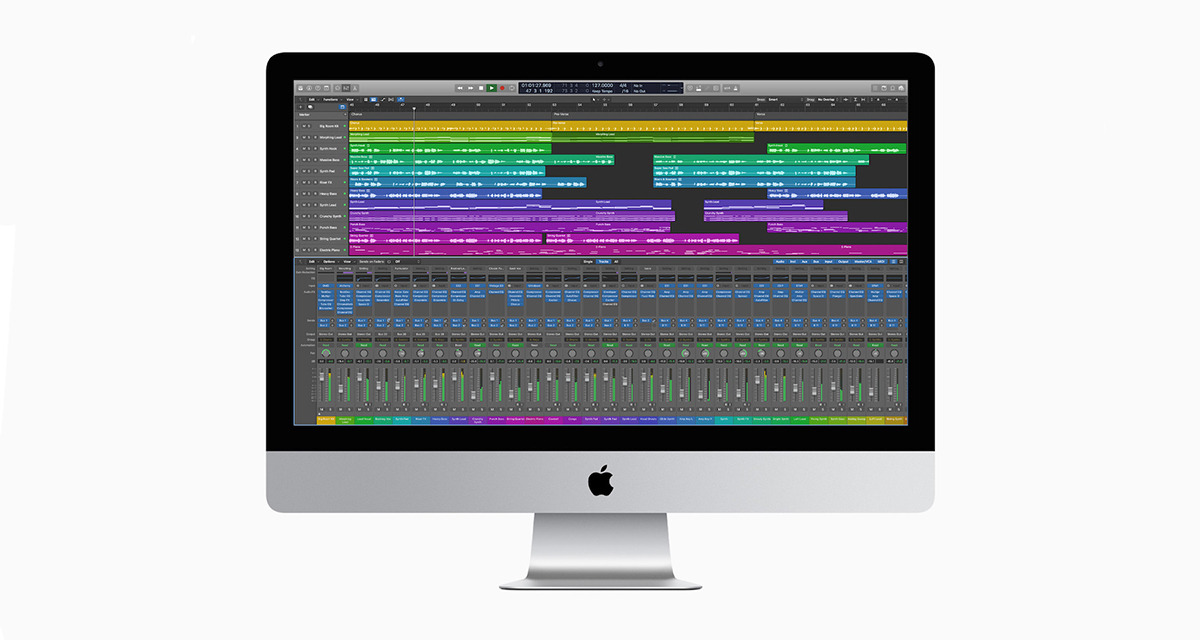Although the iMac Pro carries Apple's professional designation, your money may be better spent on a 2020 27-inch iMac.
Before the refresh of the standard iMac on Tuesday, the iMac Pro was really the only choice for a workstation-class Apple all-in-one. With a few key upgrades, however, the 27-inch iMac has taken its throne.
Here's how the base model iMac Pro, which starts at $4,999, compares to a 27-inch iMac upgraded to the same price. Both are discounted with exclusive promo code deals found in the AppleInsider Mac Price Guide.
iMac Pro versus $4999 27-inch iMac — Specifications
For the purposes of this comparison, we've taken the 27-inch iMac and made key upgrades to bring its price up to $4,999 to match the base model iMac Pro.
| $4,999 27-inch iMac (2020) | $4,999 Base iMac Pro (2017) | |
|---|---|---|
| Processor | 3.6GHz 10-core, 10th-generation Intel Core i9 processor, Turbo Boost up to 5.0GHz | 3.0GHz 10-core Intel Xeon W processor, Turbo Boost up to 4.5GHz |
| Graphics | Radeon Pro 5700 XT with 16GB of GDDR6 memory | Radeon Pro Vega 56 with 8GB of HBM2 memory |
| RAM | 32GB of 2666MHz DDR4 | 32GB of 2666MHz DDR4 ECC |
| Internal storage | 2TB SSD | 1TB SSD |
| Display | 5120 x 2880 Retina display True Tone Nano-texture glass | 5120 x 2880 Retina display |
| Connectivity | 802.11ac Wi-Fi Bluetooth 5.0 10Gb Ethernet | 802.11ac Wi-Fi Bluetooth 5.0 10Gb Ethernet |
| Microphone + Camera | 1080p FaceTime Camera Studio-quality, three-mic array | 1080p FaceTime camera Four-microphone array |
| Video output | Up to two 6K displays at 60Hz, one 5K at 60Hz, or two 4K displays at 60Hz | Up to two 5K displays at 60Hz or up to four 4K UHD displays at 60Hz |
| T2 Chip | Yes | Yes |
| Ports | Two Thunderbolt 3 ports, Four USB A, SDXC | Four Thunderbolt 3 ports, Four USB A, SDXC |
| T2 Chip | Yes | Yes |
| Price | $4,999 Lowest 27-inch iMac prices | $4,999 Lowest iMac Pro prices |
iMac Pro versus $4999 27-inch iMac — Performance
When the iMac Pro first launched in 2017, Apple touted it as the most powerful Mac that it had ever made. That was three years ago, however.
The base model iMac Pro is equipped with a 10-core Intel Xeon W processor, which is a workstation-class chip rated at 3.0GHz with Turbo Boost up to 4.5GHz.
It's been long enough without an update that the 27-inch iMac's consumer-grade Intel chip is faster, however. The top-line iMac processor — a 10-core, 10th-generation Intel Core i9 CPU Comet Lake chip — is rated at 3.6GHz with Turbo Boost speeds up to 5.0GHz.
Although benchmarks aren't always indicative of real-world performance for any given user, there are a useful in this instance. The iMac Pro in this comparison clocks in with a single-core score of 1125 and a multi-core score of about 9480 in Geekbench 5 testing, at about 140W TDP. It remains a custom part for the iMac Pro.
Although it isn't yet clear which specific chip model the new iMac has, it's based on the Comet Lake architecture and is probably the Intel Core i9-10910. This Comet Lake Intel Core i9 processor benchmarked a single-core score of about 1420 and a multi-core score of around 11000, with about 125W TDP.
What is a question here, is the thermal situation between the two machines. To handle that 140W, The iMac Pro had a custom cooling situation, and eschewed the RAM door to get that done. The 27-inch iMac still has that door — but also has a different motherboard than previous models and slightly less TDP. We'll know more about this after we get our hands on the new iMac.
iMac Pro versus $4999 27-inch iMac — input and output
Input and output, networking, and Wi-Fi are very close. Both are still using 802.11ac, both have Bluetooth 5.0. The iMac Pro has four 40 Gbit/second Thunderbolt 3 ports versus two on the 27-inch iMac, and both have four 5Gbit/second USB-A ports.
This is a big differentiator to those with a large number of external devices, or multiple monitors that need to be connected externally. This can be avoided somewhat with external Thunderbolt 3 docks or eGPUs, but this may be the determining factor between models for those with big input and output needs.
iMac Pro versus $4999 27-inch iMac — RAM & internal storage
Comparing the 27-inch iMac to the iMac Pro gets a bit more interesting when it comes to RAM and internal storage. Both upgrade options can cost a user a lot of money at the time of purchase.
Apple's iMac Pro comes standard with 1TB of internal SSD storage. Upgrading the iMac's SSD to 1TB costs an additional $200, though we've chosen to bump that up to 2TB in our comparison.
There are two main differences when dealing with RAM between the two machines given that the speed is effectively the same between the two models — the RAM door for user upgrades on the 27-inch iMac, and the ECC RAM on the iMac Pro.
As we discussed on Wednesday, you already know if you need ECC RAM. Most don't.
Furthermore, we don't recommend users upgrade their 27-inch iMac RAM at the time of purchase. For this analysis, given that the vast majority of users stick with the RAM that they purchased originally, we've chosen to bring the model in-line with the iMac Pro's baseline RAM of 32GB.
iMac Pro versus $4999 27-inch iMac — Graphics
The base model iMac Pro sports a Radeon Pro Vega 56 with 8GB of HBM2 memory. The 2020 27-inch iMac comes standard with a Radeon Pro 5500 XT with 8GB of GDDR6 memory, but we configured it with a Radeon Pro 5700 XT with 16GB.
Looking at benchmarks, the Radeon 5700 XT delivers much better performance across several metrics. And that's the Radeon 5700 XT equipped with 8GB of RAM, and not 16GB like our model.
While it gets the job done, the Vega 56 in the iMac Pro is starting to show its relative age. And, supplies of the chip suitable for the iMac Pro and eGPU solutions like the BlackMagic one are running low.
iMac Pro versus $4999 27-inch iMac — Display
The iMac Pro and the 2020 27-inch iMac have what is essentially the same display. Both have a 27-inch Retina 5K display with a resolution of 5120 x 2880 and support for one billion colors. They both feature P3 wide color support and 500 nits of brightness.
As with our previous iMac comparison, there are two noteworthy differences with the new 27-inch iMac model.
For one, the 27-inch iMac now features a True Tone display, which should make reading a bit easier on the eyes in some cases.
Like we've done in this like-price comparison, the 27-inch iMac can also be configured with Apple's high-quality, anti-reflective nano-texture glass. For the purposes of this comparison, we've configured our iMac with the feature as a point of departure with the iMac Pro. The iMac Pro doesn't currently support the upgrade.
iMac Pro versus $4999 27-inch iMac — the final verdict
The iMac Pro was at the very pinnacle of Apple's desktop lineup when it launched in 2017. Since then, it's been dethroned by the Mac Pro in terms of raw desktop performance.
But now, with the release of the refreshed 27-inch iMac, the internals on the iMac Pro is certainly showing its age. Our comparison proves that you'll get more bang for your buck if you upgrade a 27-inch iMac than you would for a base iMac Pro.
That's not even considering the fact that you can upgrade the RAM in the 27-inch iMac yourself, and save $600 while doing so. And, you can leave off the $500 for the nano-texture display too. This results in an all-in-one machine with slightly more performance for most users, for $1100 less, depending on where you get your RAM.
In other words, the 27-inch iMac is going to be a better and faster computer for just about every type of user. As we mentioned, that's due to the iMac Pro's age. But until Apple issues an actual update of its all-in-one workstation, we recommend the 27-inch iMac in almost every scenario.
Lowest prices on 2020 iMacs
Shoppers looking to pick up a new iMac can save on both the 27-inch iMac and the iMac Pro with coupon deals available exclusively at AppleInsider. Details can be found in the 2020 27-inch iMac Price Guide and the 2020 iMac Pro Price Guide.
 Mike Peterson
Mike Peterson



-m.jpg)






 Marko Zivkovic
Marko Zivkovic
 Mike Wuerthele
Mike Wuerthele
 Christine McKee
Christine McKee
 Amber Neely
Amber Neely
 Wesley Hilliard
Wesley Hilliard

 William Gallagher
William Gallagher










20 Comments
Comparisons based on specs alone aren’t particularly useful. A side by side comparison of how they perform in the real world would be a lot more informative.
Isn't the new SD card slot UHS-II? That would be a bonus. And isn't the 5700XT known for producing a lot of heat & noise? I wonder how that will work inside the old iMac case.
But it doesn't come in space grey. Everyone knows that pros require darker, edgier equipment.
I'm somewhat surprised that Apple didn't knock a few (hundred) bucks off the pro, but perhaps they would actually prefer that consumers do the obvious thing and buy the new model instead.